Auditing Theory and Practice 1: Issues in Auditing
VerifiedAdded on 2020/05/16
|12
|2370
|339
Report
AI Summary
This report delves into various issues within auditing theory and practice, focusing on the audit of Ryanco Company. It begins with a discussion of audit planning, analytical review, and the preliminary judgment on materiality. The report then examines specific accounts from the company's financial statements, including gross profit margin, net profit, inventory, wages, superannuation, and other income. For each account, the report provides a rationale for selection, explains the relevant assertions, and recommends specific audit procedures. The analysis highlights potential risks and areas of concern, offering insights into how auditors can effectively assess and verify the accuracy of financial information. The report emphasizes the importance of understanding business operations and applying appropriate audit techniques to detect potential misstatements and ensure the reliability of financial statements. The student report is now available on Desklib.
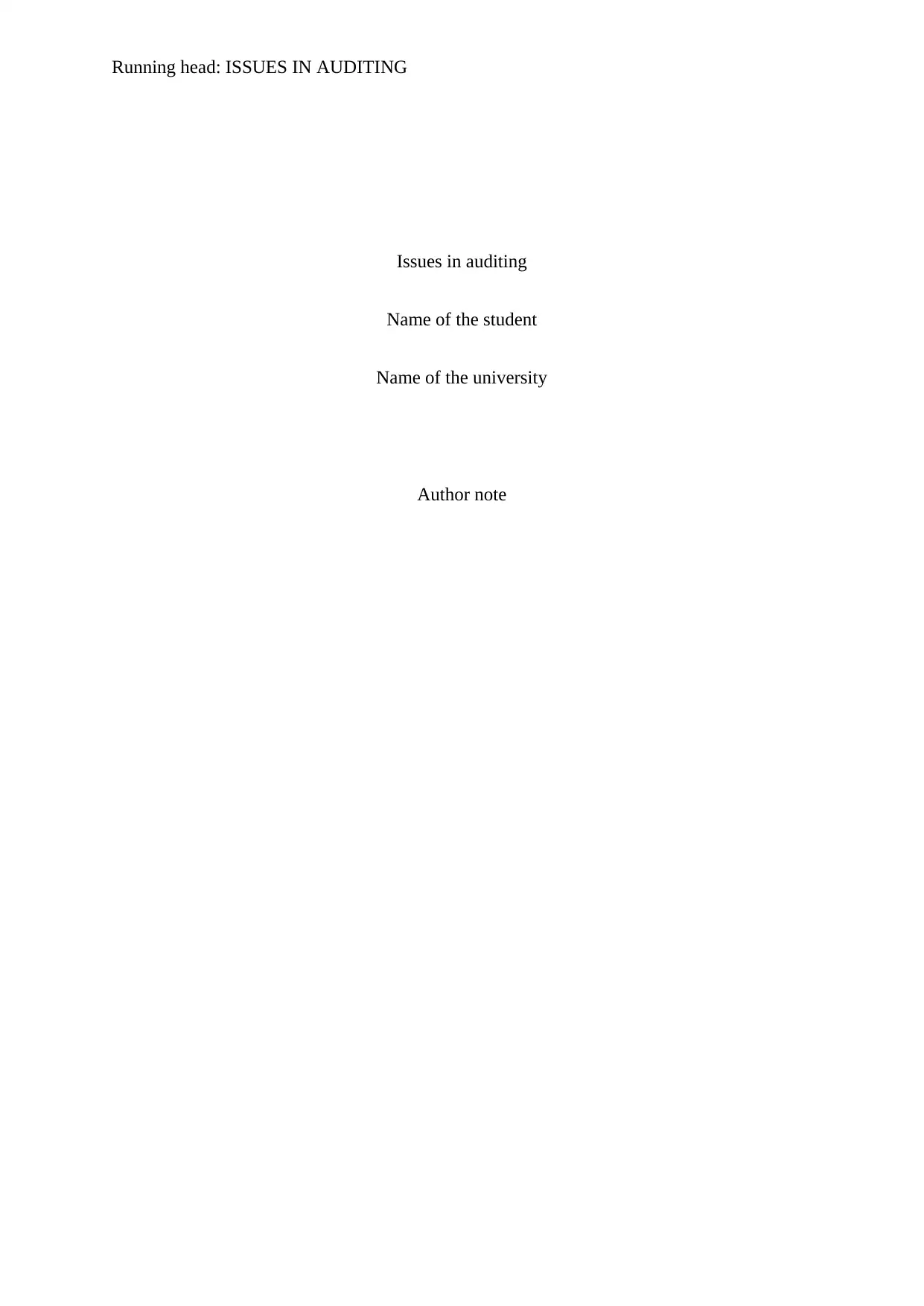
Running head: ISSUES IN AUDITING
Issues in auditing
Name of the student
Name of the university
Author note
Issues in auditing
Name of the student
Name of the university
Author note
Paraphrase This Document
Need a fresh take? Get an instant paraphrase of this document with our AI Paraphraser
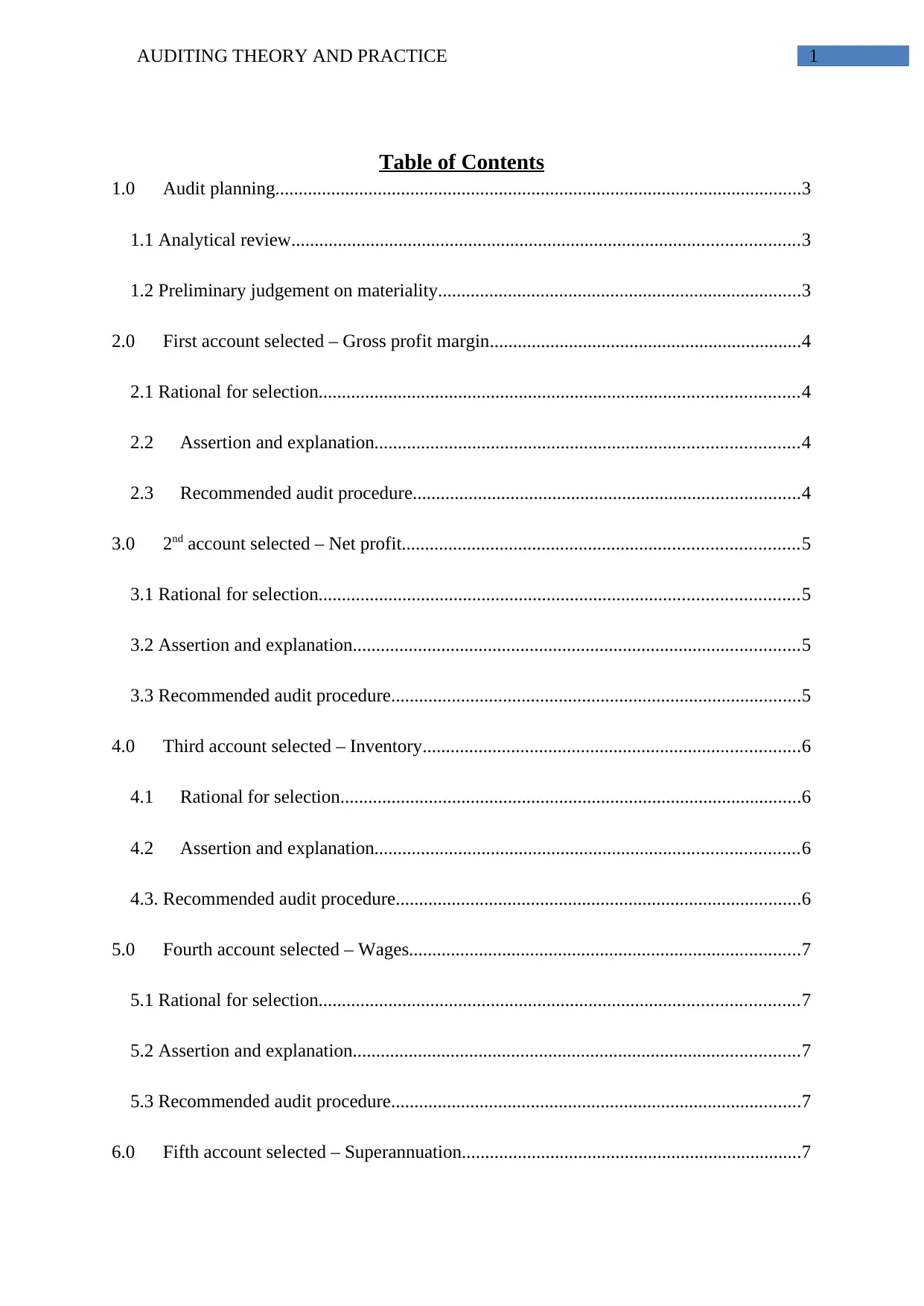
AUDITING THEORY AND PRACTICE 1
Table of Contents
1.0 Audit planning.................................................................................................................3
1.1 Analytical review.............................................................................................................3
1.2 Preliminary judgement on materiality..............................................................................3
2.0 First account selected – Gross profit margin...................................................................4
2.1 Rational for selection.......................................................................................................4
2.2 Assertion and explanation...........................................................................................4
2.3 Recommended audit procedure...................................................................................4
3.0 2nd account selected – Net profit.....................................................................................5
3.1 Rational for selection.......................................................................................................5
3.2 Assertion and explanation................................................................................................5
3.3 Recommended audit procedure........................................................................................5
4.0 Third account selected – Inventory.................................................................................6
4.1 Rational for selection...................................................................................................6
4.2 Assertion and explanation...........................................................................................6
4.3. Recommended audit procedure.......................................................................................6
5.0 Fourth account selected – Wages....................................................................................7
5.1 Rational for selection.......................................................................................................7
5.2 Assertion and explanation................................................................................................7
5.3 Recommended audit procedure........................................................................................7
6.0 Fifth account selected – Superannuation.........................................................................7
Table of Contents
1.0 Audit planning.................................................................................................................3
1.1 Analytical review.............................................................................................................3
1.2 Preliminary judgement on materiality..............................................................................3
2.0 First account selected – Gross profit margin...................................................................4
2.1 Rational for selection.......................................................................................................4
2.2 Assertion and explanation...........................................................................................4
2.3 Recommended audit procedure...................................................................................4
3.0 2nd account selected – Net profit.....................................................................................5
3.1 Rational for selection.......................................................................................................5
3.2 Assertion and explanation................................................................................................5
3.3 Recommended audit procedure........................................................................................5
4.0 Third account selected – Inventory.................................................................................6
4.1 Rational for selection...................................................................................................6
4.2 Assertion and explanation...........................................................................................6
4.3. Recommended audit procedure.......................................................................................6
5.0 Fourth account selected – Wages....................................................................................7
5.1 Rational for selection.......................................................................................................7
5.2 Assertion and explanation................................................................................................7
5.3 Recommended audit procedure........................................................................................7
6.0 Fifth account selected – Superannuation.........................................................................7

AUDITING THEORY AND PRACTICE 2
6.1 Rational for selection.......................................................................................................7
6.2 Assertion and explanation................................................................................................8
6.3 Recommended procedure.................................................................................................8
7.0 Sixth account selected – Other income................................................................................8
7.1 Rational for selection.......................................................................................................8
7.2 Assertion and explanation................................................................................................8
7.3 Recommended procedure.................................................................................................9
Reference..................................................................................................................................10
6.1 Rational for selection.......................................................................................................7
6.2 Assertion and explanation................................................................................................8
6.3 Recommended procedure.................................................................................................8
7.0 Sixth account selected – Other income................................................................................8
7.1 Rational for selection.......................................................................................................8
7.2 Assertion and explanation................................................................................................8
7.3 Recommended procedure.................................................................................................9
Reference..................................................................................................................................10
⊘ This is a preview!⊘
Do you want full access?
Subscribe today to unlock all pages.

Trusted by 1+ million students worldwide
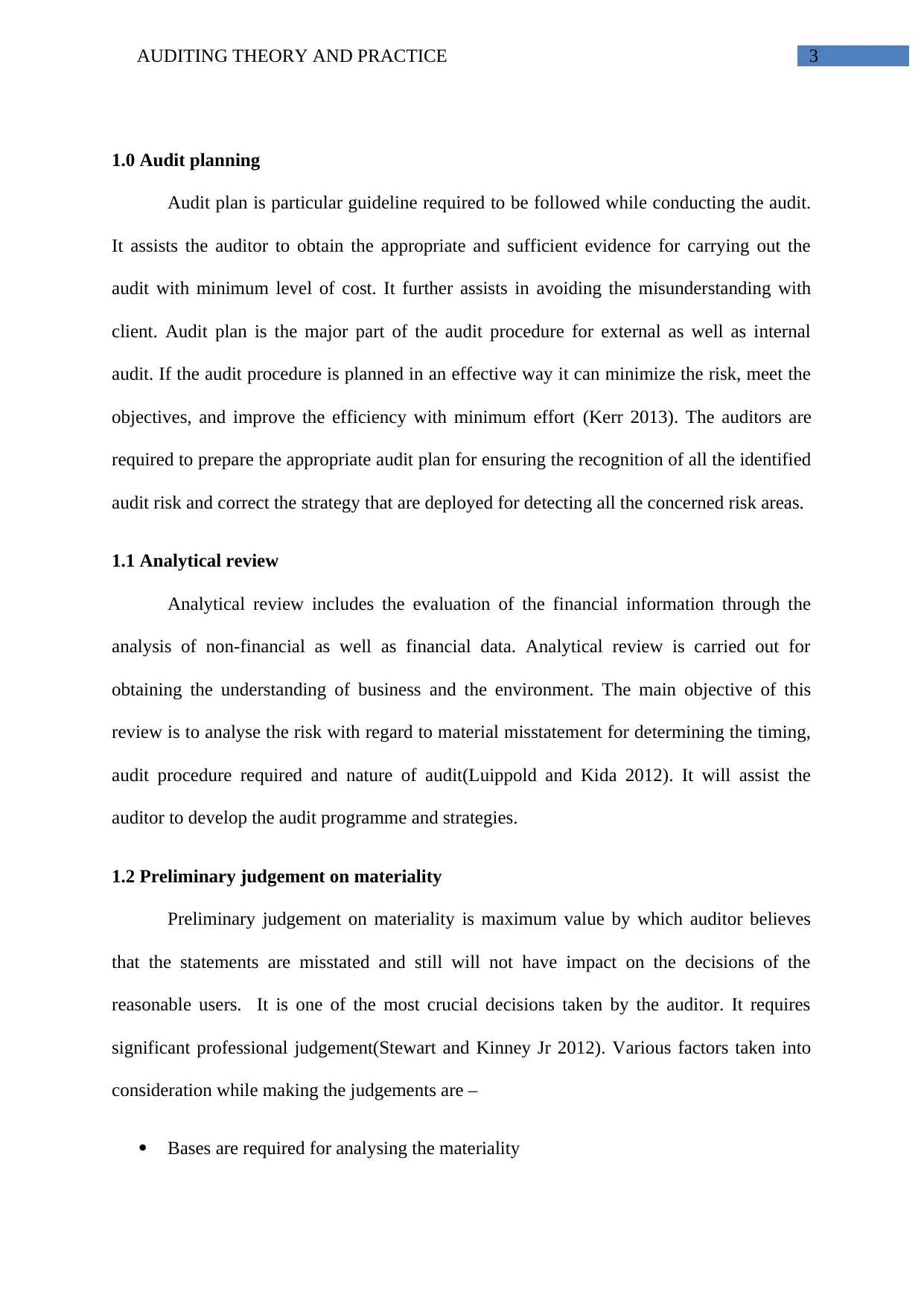
AUDITING THEORY AND PRACTICE 3
1.0 Audit planning
Audit plan is particular guideline required to be followed while conducting the audit.
It assists the auditor to obtain the appropriate and sufficient evidence for carrying out the
audit with minimum level of cost. It further assists in avoiding the misunderstanding with
client. Audit plan is the major part of the audit procedure for external as well as internal
audit. If the audit procedure is planned in an effective way it can minimize the risk, meet the
objectives, and improve the efficiency with minimum effort (Kerr 2013). The auditors are
required to prepare the appropriate audit plan for ensuring the recognition of all the identified
audit risk and correct the strategy that are deployed for detecting all the concerned risk areas.
1.1 Analytical review
Analytical review includes the evaluation of the financial information through the
analysis of non-financial as well as financial data. Analytical review is carried out for
obtaining the understanding of business and the environment. The main objective of this
review is to analyse the risk with regard to material misstatement for determining the timing,
audit procedure required and nature of audit(Luippold and Kida 2012). It will assist the
auditor to develop the audit programme and strategies.
1.2 Preliminary judgement on materiality
Preliminary judgement on materiality is maximum value by which auditor believes
that the statements are misstated and still will not have impact on the decisions of the
reasonable users. It is one of the most crucial decisions taken by the auditor. It requires
significant professional judgement(Stewart and Kinney Jr 2012). Various factors taken into
consideration while making the judgements are –
Bases are required for analysing the materiality
1.0 Audit planning
Audit plan is particular guideline required to be followed while conducting the audit.
It assists the auditor to obtain the appropriate and sufficient evidence for carrying out the
audit with minimum level of cost. It further assists in avoiding the misunderstanding with
client. Audit plan is the major part of the audit procedure for external as well as internal
audit. If the audit procedure is planned in an effective way it can minimize the risk, meet the
objectives, and improve the efficiency with minimum effort (Kerr 2013). The auditors are
required to prepare the appropriate audit plan for ensuring the recognition of all the identified
audit risk and correct the strategy that are deployed for detecting all the concerned risk areas.
1.1 Analytical review
Analytical review includes the evaluation of the financial information through the
analysis of non-financial as well as financial data. Analytical review is carried out for
obtaining the understanding of business and the environment. The main objective of this
review is to analyse the risk with regard to material misstatement for determining the timing,
audit procedure required and nature of audit(Luippold and Kida 2012). It will assist the
auditor to develop the audit programme and strategies.
1.2 Preliminary judgement on materiality
Preliminary judgement on materiality is maximum value by which auditor believes
that the statements are misstated and still will not have impact on the decisions of the
reasonable users. It is one of the most crucial decisions taken by the auditor. It requires
significant professional judgement(Stewart and Kinney Jr 2012). Various factors taken into
consideration while making the judgements are –
Bases are required for analysing the materiality
Paraphrase This Document
Need a fresh take? Get an instant paraphrase of this document with our AI Paraphraser
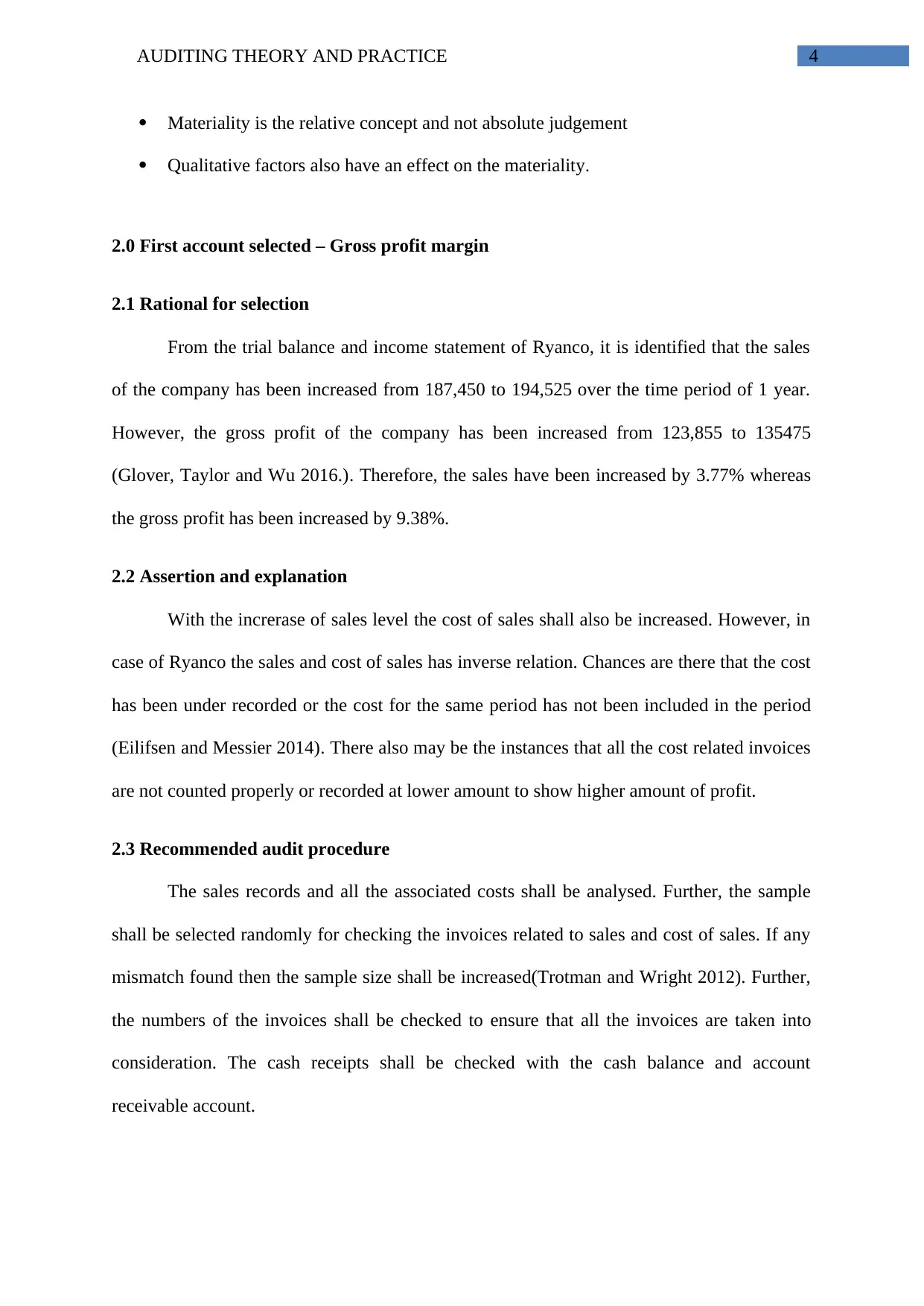
AUDITING THEORY AND PRACTICE 4
Materiality is the relative concept and not absolute judgement
Qualitative factors also have an effect on the materiality.
2.0 First account selected – Gross profit margin
2.1 Rational for selection
From the trial balance and income statement of Ryanco, it is identified that the sales
of the company has been increased from 187,450 to 194,525 over the time period of 1 year.
However, the gross profit of the company has been increased from 123,855 to 135475
(Glover, Taylor and Wu 2016.). Therefore, the sales have been increased by 3.77% whereas
the gross profit has been increased by 9.38%.
2.2 Assertion and explanation
With the increrase of sales level the cost of sales shall also be increased. However, in
case of Ryanco the sales and cost of sales has inverse relation. Chances are there that the cost
has been under recorded or the cost for the same period has not been included in the period
(Eilifsen and Messier 2014). There also may be the instances that all the cost related invoices
are not counted properly or recorded at lower amount to show higher amount of profit.
2.3 Recommended audit procedure
The sales records and all the associated costs shall be analysed. Further, the sample
shall be selected randomly for checking the invoices related to sales and cost of sales. If any
mismatch found then the sample size shall be increased(Trotman and Wright 2012). Further,
the numbers of the invoices shall be checked to ensure that all the invoices are taken into
consideration. The cash receipts shall be checked with the cash balance and account
receivable account.
Materiality is the relative concept and not absolute judgement
Qualitative factors also have an effect on the materiality.
2.0 First account selected – Gross profit margin
2.1 Rational for selection
From the trial balance and income statement of Ryanco, it is identified that the sales
of the company has been increased from 187,450 to 194,525 over the time period of 1 year.
However, the gross profit of the company has been increased from 123,855 to 135475
(Glover, Taylor and Wu 2016.). Therefore, the sales have been increased by 3.77% whereas
the gross profit has been increased by 9.38%.
2.2 Assertion and explanation
With the increrase of sales level the cost of sales shall also be increased. However, in
case of Ryanco the sales and cost of sales has inverse relation. Chances are there that the cost
has been under recorded or the cost for the same period has not been included in the period
(Eilifsen and Messier 2014). There also may be the instances that all the cost related invoices
are not counted properly or recorded at lower amount to show higher amount of profit.
2.3 Recommended audit procedure
The sales records and all the associated costs shall be analysed. Further, the sample
shall be selected randomly for checking the invoices related to sales and cost of sales. If any
mismatch found then the sample size shall be increased(Trotman and Wright 2012). Further,
the numbers of the invoices shall be checked to ensure that all the invoices are taken into
consideration. The cash receipts shall be checked with the cash balance and account
receivable account.
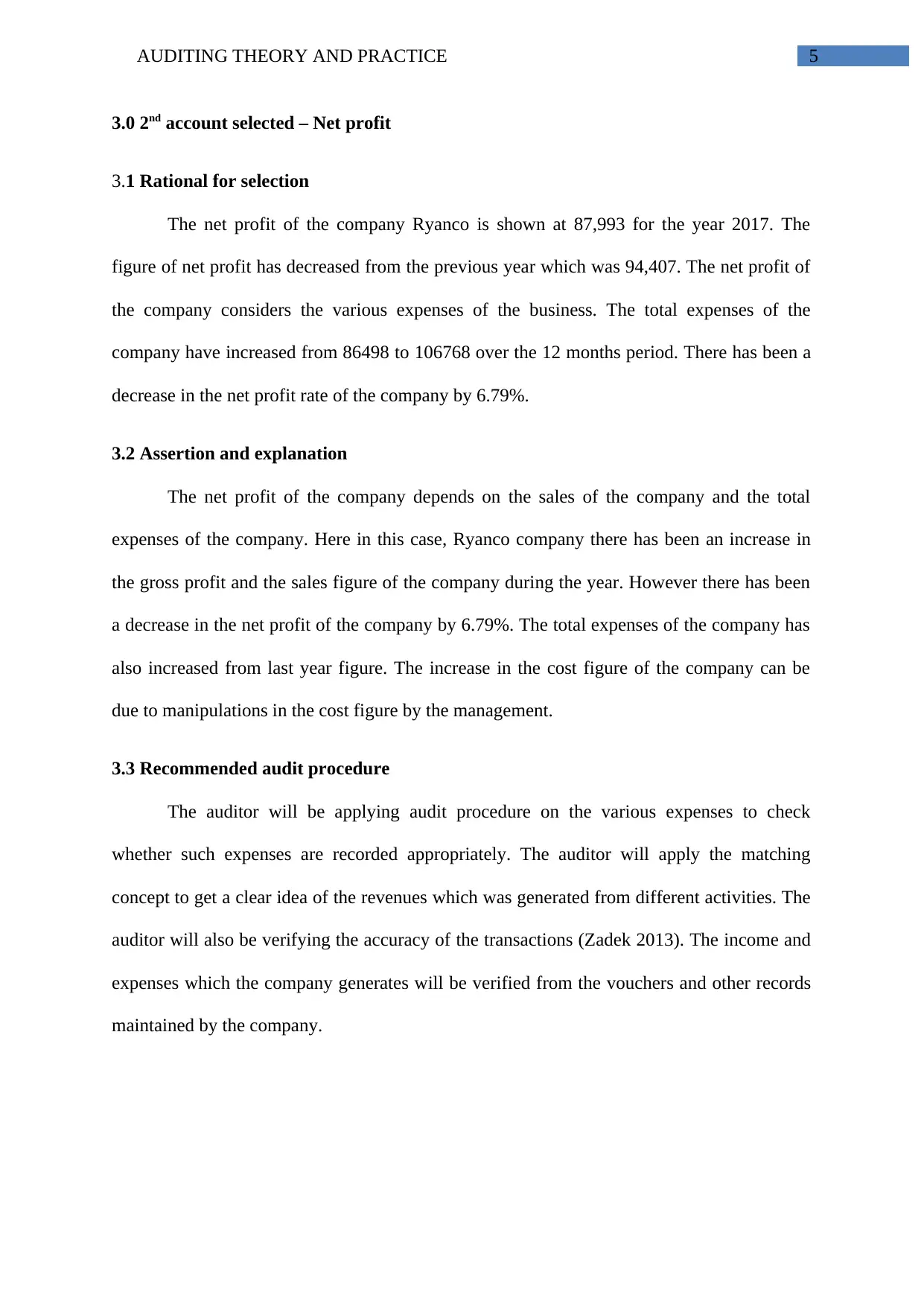
AUDITING THEORY AND PRACTICE 5
3.0 2nd account selected – Net profit
3.1 Rational for selection
The net profit of the company Ryanco is shown at 87,993 for the year 2017. The
figure of net profit has decreased from the previous year which was 94,407. The net profit of
the company considers the various expenses of the business. The total expenses of the
company have increased from 86498 to 106768 over the 12 months period. There has been a
decrease in the net profit rate of the company by 6.79%.
3.2 Assertion and explanation
The net profit of the company depends on the sales of the company and the total
expenses of the company. Here in this case, Ryanco company there has been an increase in
the gross profit and the sales figure of the company during the year. However there has been
a decrease in the net profit of the company by 6.79%. The total expenses of the company has
also increased from last year figure. The increase in the cost figure of the company can be
due to manipulations in the cost figure by the management.
3.3 Recommended audit procedure
The auditor will be applying audit procedure on the various expenses to check
whether such expenses are recorded appropriately. The auditor will apply the matching
concept to get a clear idea of the revenues which was generated from different activities. The
auditor will also be verifying the accuracy of the transactions (Zadek 2013). The income and
expenses which the company generates will be verified from the vouchers and other records
maintained by the company.
3.0 2nd account selected – Net profit
3.1 Rational for selection
The net profit of the company Ryanco is shown at 87,993 for the year 2017. The
figure of net profit has decreased from the previous year which was 94,407. The net profit of
the company considers the various expenses of the business. The total expenses of the
company have increased from 86498 to 106768 over the 12 months period. There has been a
decrease in the net profit rate of the company by 6.79%.
3.2 Assertion and explanation
The net profit of the company depends on the sales of the company and the total
expenses of the company. Here in this case, Ryanco company there has been an increase in
the gross profit and the sales figure of the company during the year. However there has been
a decrease in the net profit of the company by 6.79%. The total expenses of the company has
also increased from last year figure. The increase in the cost figure of the company can be
due to manipulations in the cost figure by the management.
3.3 Recommended audit procedure
The auditor will be applying audit procedure on the various expenses to check
whether such expenses are recorded appropriately. The auditor will apply the matching
concept to get a clear idea of the revenues which was generated from different activities. The
auditor will also be verifying the accuracy of the transactions (Zadek 2013). The income and
expenses which the company generates will be verified from the vouchers and other records
maintained by the company.
⊘ This is a preview!⊘
Do you want full access?
Subscribe today to unlock all pages.

Trusted by 1+ million students worldwide
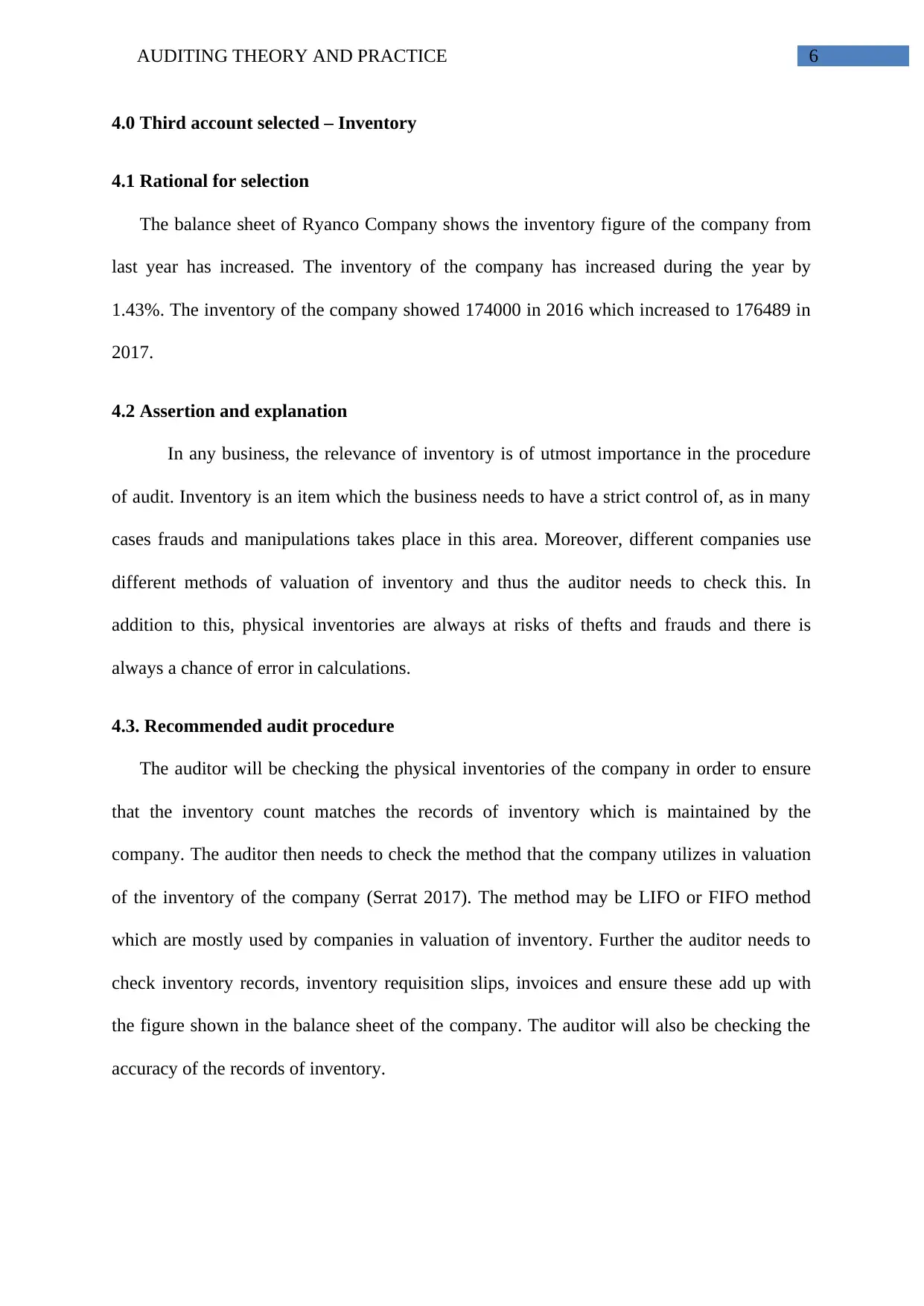
AUDITING THEORY AND PRACTICE 6
4.0 Third account selected – Inventory
4.1 Rational for selection
The balance sheet of Ryanco Company shows the inventory figure of the company from
last year has increased. The inventory of the company has increased during the year by
1.43%. The inventory of the company showed 174000 in 2016 which increased to 176489 in
2017.
4.2 Assertion and explanation
In any business, the relevance of inventory is of utmost importance in the procedure
of audit. Inventory is an item which the business needs to have a strict control of, as in many
cases frauds and manipulations takes place in this area. Moreover, different companies use
different methods of valuation of inventory and thus the auditor needs to check this. In
addition to this, physical inventories are always at risks of thefts and frauds and there is
always a chance of error in calculations.
4.3. Recommended audit procedure
The auditor will be checking the physical inventories of the company in order to ensure
that the inventory count matches the records of inventory which is maintained by the
company. The auditor then needs to check the method that the company utilizes in valuation
of the inventory of the company (Serrat 2017). The method may be LIFO or FIFO method
which are mostly used by companies in valuation of inventory. Further the auditor needs to
check inventory records, inventory requisition slips, invoices and ensure these add up with
the figure shown in the balance sheet of the company. The auditor will also be checking the
accuracy of the records of inventory.
4.0 Third account selected – Inventory
4.1 Rational for selection
The balance sheet of Ryanco Company shows the inventory figure of the company from
last year has increased. The inventory of the company has increased during the year by
1.43%. The inventory of the company showed 174000 in 2016 which increased to 176489 in
2017.
4.2 Assertion and explanation
In any business, the relevance of inventory is of utmost importance in the procedure
of audit. Inventory is an item which the business needs to have a strict control of, as in many
cases frauds and manipulations takes place in this area. Moreover, different companies use
different methods of valuation of inventory and thus the auditor needs to check this. In
addition to this, physical inventories are always at risks of thefts and frauds and there is
always a chance of error in calculations.
4.3. Recommended audit procedure
The auditor will be checking the physical inventories of the company in order to ensure
that the inventory count matches the records of inventory which is maintained by the
company. The auditor then needs to check the method that the company utilizes in valuation
of the inventory of the company (Serrat 2017). The method may be LIFO or FIFO method
which are mostly used by companies in valuation of inventory. Further the auditor needs to
check inventory records, inventory requisition slips, invoices and ensure these add up with
the figure shown in the balance sheet of the company. The auditor will also be checking the
accuracy of the records of inventory.
Paraphrase This Document
Need a fresh take? Get an instant paraphrase of this document with our AI Paraphraser
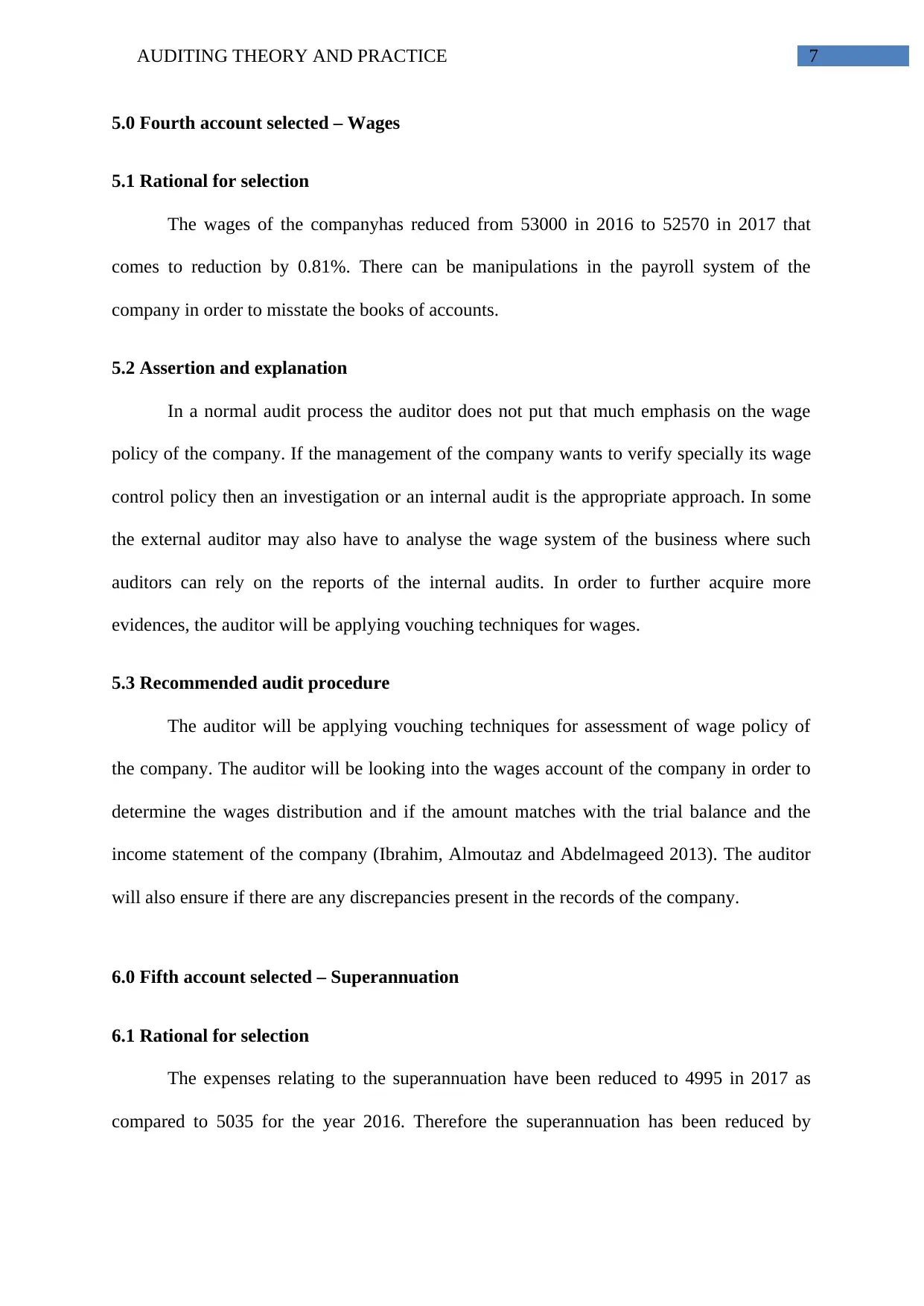
AUDITING THEORY AND PRACTICE 7
5.0 Fourth account selected – Wages
5.1 Rational for selection
The wages of the companyhas reduced from 53000 in 2016 to 52570 in 2017 that
comes to reduction by 0.81%. There can be manipulations in the payroll system of the
company in order to misstate the books of accounts.
5.2 Assertion and explanation
In a normal audit process the auditor does not put that much emphasis on the wage
policy of the company. If the management of the company wants to verify specially its wage
control policy then an investigation or an internal audit is the appropriate approach. In some
the external auditor may also have to analyse the wage system of the business where such
auditors can rely on the reports of the internal audits. In order to further acquire more
evidences, the auditor will be applying vouching techniques for wages.
5.3 Recommended audit procedure
The auditor will be applying vouching techniques for assessment of wage policy of
the company. The auditor will be looking into the wages account of the company in order to
determine the wages distribution and if the amount matches with the trial balance and the
income statement of the company (Ibrahim, Almoutaz and Abdelmageed 2013). The auditor
will also ensure if there are any discrepancies present in the records of the company.
6.0 Fifth account selected – Superannuation
6.1 Rational for selection
The expenses relating to the superannuation have been reduced to 4995 in 2017 as
compared to 5035 for the year 2016. Therefore the superannuation has been reduced by
5.0 Fourth account selected – Wages
5.1 Rational for selection
The wages of the companyhas reduced from 53000 in 2016 to 52570 in 2017 that
comes to reduction by 0.81%. There can be manipulations in the payroll system of the
company in order to misstate the books of accounts.
5.2 Assertion and explanation
In a normal audit process the auditor does not put that much emphasis on the wage
policy of the company. If the management of the company wants to verify specially its wage
control policy then an investigation or an internal audit is the appropriate approach. In some
the external auditor may also have to analyse the wage system of the business where such
auditors can rely on the reports of the internal audits. In order to further acquire more
evidences, the auditor will be applying vouching techniques for wages.
5.3 Recommended audit procedure
The auditor will be applying vouching techniques for assessment of wage policy of
the company. The auditor will be looking into the wages account of the company in order to
determine the wages distribution and if the amount matches with the trial balance and the
income statement of the company (Ibrahim, Almoutaz and Abdelmageed 2013). The auditor
will also ensure if there are any discrepancies present in the records of the company.
6.0 Fifth account selected – Superannuation
6.1 Rational for selection
The expenses relating to the superannuation have been reduced to 4995 in 2017 as
compared to 5035 for the year 2016. Therefore the superannuation has been reduced by
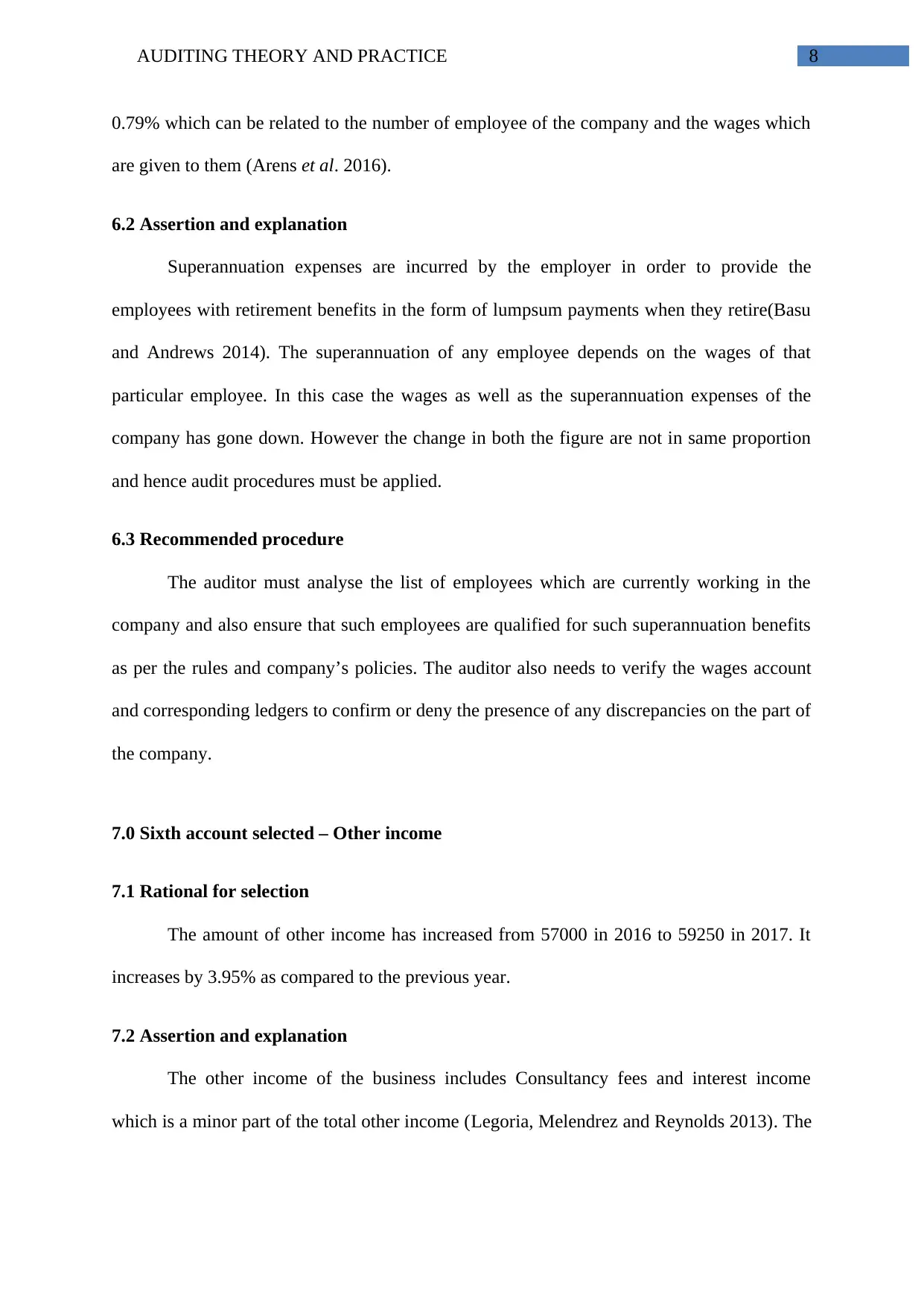
AUDITING THEORY AND PRACTICE 8
0.79% which can be related to the number of employee of the company and the wages which
are given to them (Arens et al. 2016).
6.2 Assertion and explanation
Superannuation expenses are incurred by the employer in order to provide the
employees with retirement benefits in the form of lumpsum payments when they retire(Basu
and Andrews 2014). The superannuation of any employee depends on the wages of that
particular employee. In this case the wages as well as the superannuation expenses of the
company has gone down. However the change in both the figure are not in same proportion
and hence audit procedures must be applied.
6.3 Recommended procedure
The auditor must analyse the list of employees which are currently working in the
company and also ensure that such employees are qualified for such superannuation benefits
as per the rules and company’s policies. The auditor also needs to verify the wages account
and corresponding ledgers to confirm or deny the presence of any discrepancies on the part of
the company.
7.0 Sixth account selected – Other income
7.1 Rational for selection
The amount of other income has increased from 57000 in 2016 to 59250 in 2017. It
increases by 3.95% as compared to the previous year.
7.2 Assertion and explanation
The other income of the business includes Consultancy fees and interest income
which is a minor part of the total other income (Legoria, Melendrez and Reynolds 2013). The
0.79% which can be related to the number of employee of the company and the wages which
are given to them (Arens et al. 2016).
6.2 Assertion and explanation
Superannuation expenses are incurred by the employer in order to provide the
employees with retirement benefits in the form of lumpsum payments when they retire(Basu
and Andrews 2014). The superannuation of any employee depends on the wages of that
particular employee. In this case the wages as well as the superannuation expenses of the
company has gone down. However the change in both the figure are not in same proportion
and hence audit procedures must be applied.
6.3 Recommended procedure
The auditor must analyse the list of employees which are currently working in the
company and also ensure that such employees are qualified for such superannuation benefits
as per the rules and company’s policies. The auditor also needs to verify the wages account
and corresponding ledgers to confirm or deny the presence of any discrepancies on the part of
the company.
7.0 Sixth account selected – Other income
7.1 Rational for selection
The amount of other income has increased from 57000 in 2016 to 59250 in 2017. It
increases by 3.95% as compared to the previous year.
7.2 Assertion and explanation
The other income of the business includes Consultancy fees and interest income
which is a minor part of the total other income (Legoria, Melendrez and Reynolds 2013). The
⊘ This is a preview!⊘
Do you want full access?
Subscribe today to unlock all pages.

Trusted by 1+ million students worldwide

AUDITING THEORY AND PRACTICE 9
auditor needs to analyse the consultancy fee part as there are chances of manipulations as
they are material enough to affect the company.
7.3 Recommended procedure
The auditor should be analysing the income receipts books and confirm the figures
recorded in the statement of income and trial balance. If the need arises the auditor can
confirm the figures as stated in the trial balance from the parties involved in the consultancy
service receivers. The auditor can also ask for management representations for the reasons for
reduction in the income of the company.
auditor needs to analyse the consultancy fee part as there are chances of manipulations as
they are material enough to affect the company.
7.3 Recommended procedure
The auditor should be analysing the income receipts books and confirm the figures
recorded in the statement of income and trial balance. If the need arises the auditor can
confirm the figures as stated in the trial balance from the parties involved in the consultancy
service receivers. The auditor can also ask for management representations for the reasons for
reduction in the income of the company.
Paraphrase This Document
Need a fresh take? Get an instant paraphrase of this document with our AI Paraphraser

AUDITING THEORY AND PRACTICE 10
Reference
Arens, A.A., Elder, R.J., Beasley, M.S. and Hogan, C.E., 2016. Auditing and assurance
services. Pearson.
Basu, A. and Andrews, S., 2014. Asset allocation policy, returns and expenses of
superannuation funds: recent evidence based on default options. Australian Economic
Review, 47(1), pp.63-77.
Eilifsen, A. and Messier Jr, W.F., 2014. Materiality guidance of the major public accounting
firms. Auditing: A Journal of Practice & Theory, 34(2), pp.3-26.
Glover, S.M., Taylor, M.H. and Wu, Y.J., 2016. Current practices and challenges in auditing
fair value measurements and complex estimates: Implications for auditing standards and the
academy. Auditing: A Journal of Practice & Theory, 36(1), pp.63-84.
Ibrahim, A., Almoutaz, M. and Abdelmageed, A.M., 2013. Factors Affecting the
Determination of Wages of Auditors and their Relative Importance (A case study of
Sudan). Nature & Science, 11(4).
Kerr, D.S., 2013. Fraud-risk factors and audit planning: The effects of auditor rank. Journal
of Forensic & Investigative Accounting, 5(2), pp.48-76.
Legoria, J., Melendrez, K.D. and Reynolds, J.K., 2013. Qualitative audit materiality and
earnings management. Review of Accounting Studies, 18(2), pp.414-442.
Luippold, B.L. and Kida, T.E., 2012. The impact of initial information ambiguity on the
accuracy of analytical review judgments. Auditing: A Journal of Practice & Theory, 31(2),
pp.113-129.
Reference
Arens, A.A., Elder, R.J., Beasley, M.S. and Hogan, C.E., 2016. Auditing and assurance
services. Pearson.
Basu, A. and Andrews, S., 2014. Asset allocation policy, returns and expenses of
superannuation funds: recent evidence based on default options. Australian Economic
Review, 47(1), pp.63-77.
Eilifsen, A. and Messier Jr, W.F., 2014. Materiality guidance of the major public accounting
firms. Auditing: A Journal of Practice & Theory, 34(2), pp.3-26.
Glover, S.M., Taylor, M.H. and Wu, Y.J., 2016. Current practices and challenges in auditing
fair value measurements and complex estimates: Implications for auditing standards and the
academy. Auditing: A Journal of Practice & Theory, 36(1), pp.63-84.
Ibrahim, A., Almoutaz, M. and Abdelmageed, A.M., 2013. Factors Affecting the
Determination of Wages of Auditors and their Relative Importance (A case study of
Sudan). Nature & Science, 11(4).
Kerr, D.S., 2013. Fraud-risk factors and audit planning: The effects of auditor rank. Journal
of Forensic & Investigative Accounting, 5(2), pp.48-76.
Legoria, J., Melendrez, K.D. and Reynolds, J.K., 2013. Qualitative audit materiality and
earnings management. Review of Accounting Studies, 18(2), pp.414-442.
Luippold, B.L. and Kida, T.E., 2012. The impact of initial information ambiguity on the
accuracy of analytical review judgments. Auditing: A Journal of Practice & Theory, 31(2),
pp.113-129.
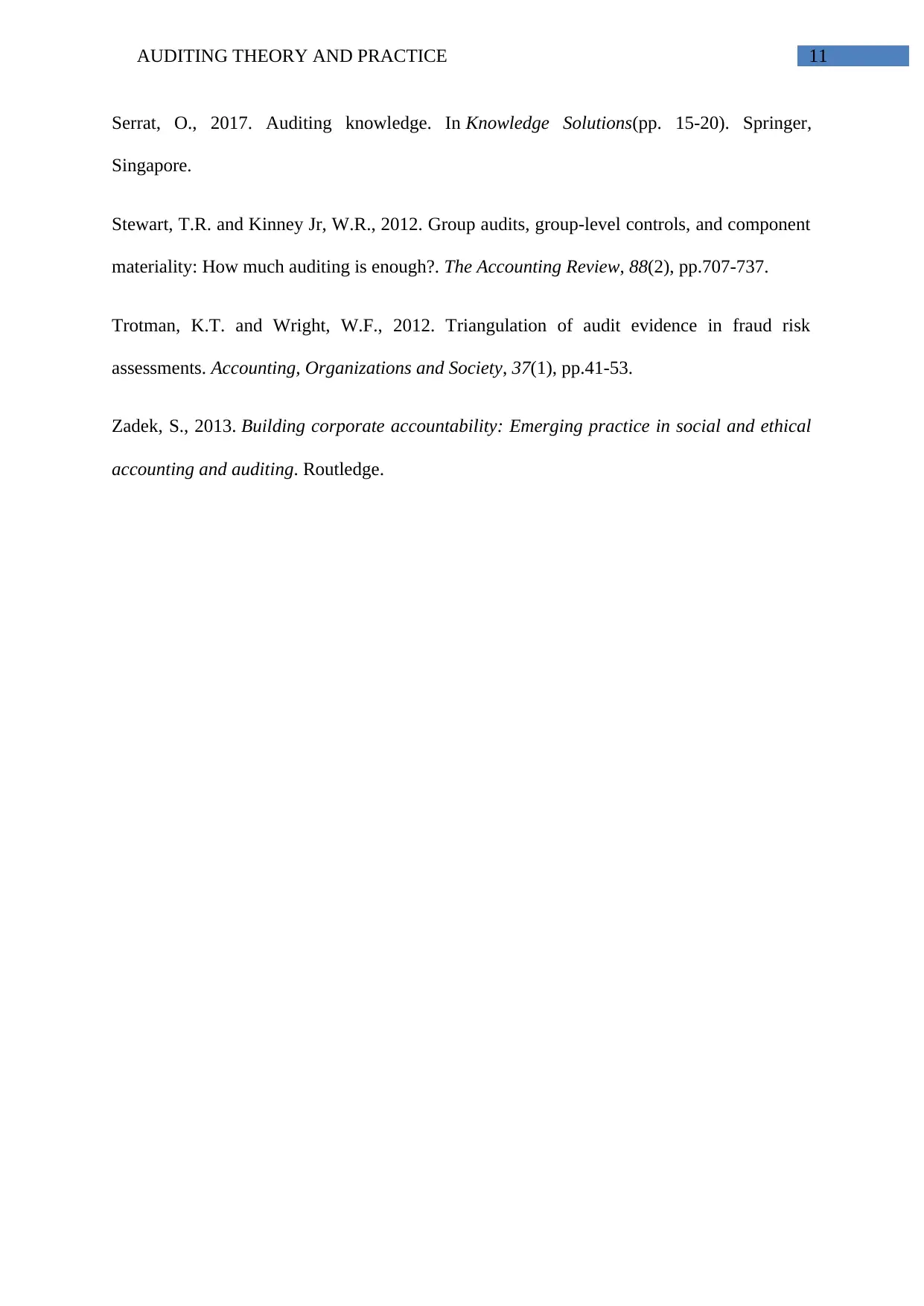
AUDITING THEORY AND PRACTICE 11
Serrat, O., 2017. Auditing knowledge. In Knowledge Solutions(pp. 15-20). Springer,
Singapore.
Stewart, T.R. and Kinney Jr, W.R., 2012. Group audits, group-level controls, and component
materiality: How much auditing is enough?. The Accounting Review, 88(2), pp.707-737.
Trotman, K.T. and Wright, W.F., 2012. Triangulation of audit evidence in fraud risk
assessments. Accounting, Organizations and Society, 37(1), pp.41-53.
Zadek, S., 2013. Building corporate accountability: Emerging practice in social and ethical
accounting and auditing. Routledge.
Serrat, O., 2017. Auditing knowledge. In Knowledge Solutions(pp. 15-20). Springer,
Singapore.
Stewart, T.R. and Kinney Jr, W.R., 2012. Group audits, group-level controls, and component
materiality: How much auditing is enough?. The Accounting Review, 88(2), pp.707-737.
Trotman, K.T. and Wright, W.F., 2012. Triangulation of audit evidence in fraud risk
assessments. Accounting, Organizations and Society, 37(1), pp.41-53.
Zadek, S., 2013. Building corporate accountability: Emerging practice in social and ethical
accounting and auditing. Routledge.
⊘ This is a preview!⊘
Do you want full access?
Subscribe today to unlock all pages.

Trusted by 1+ million students worldwide
1 out of 12
Related Documents
Your All-in-One AI-Powered Toolkit for Academic Success.
+13062052269
info@desklib.com
Available 24*7 on WhatsApp / Email
![[object Object]](/_next/static/media/star-bottom.7253800d.svg)
Unlock your academic potential
Copyright © 2020–2025 A2Z Services. All Rights Reserved. Developed and managed by ZUCOL.




